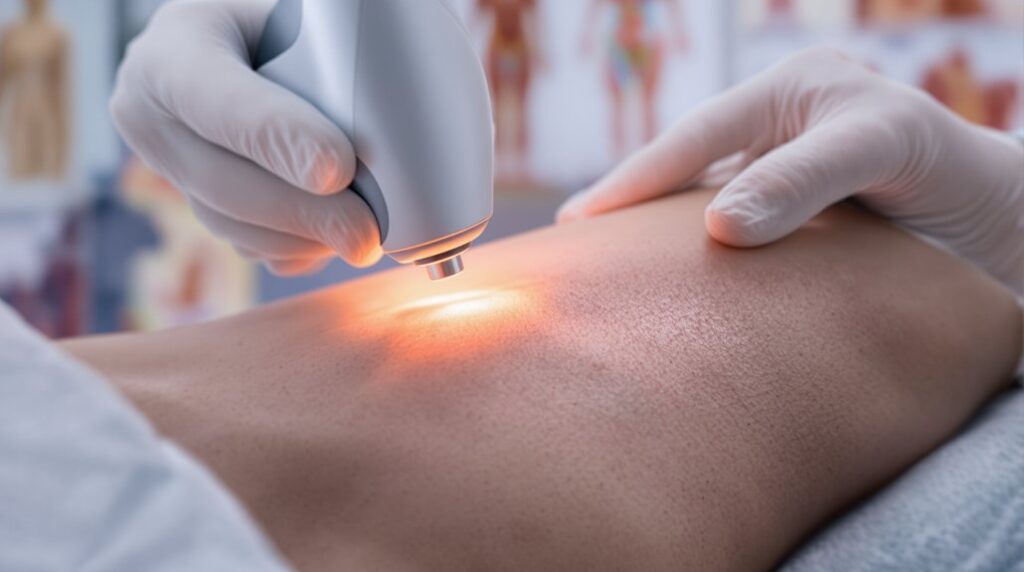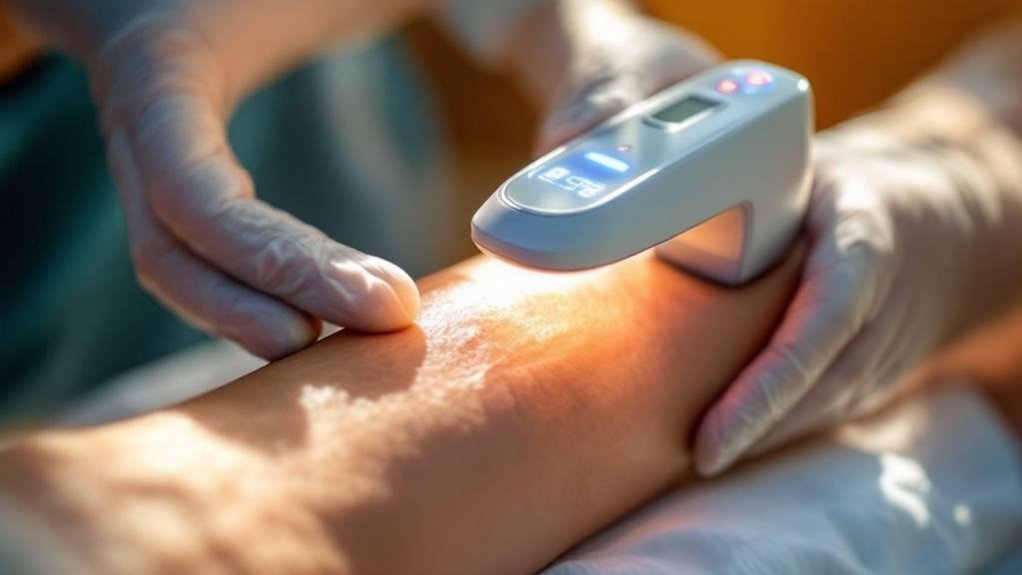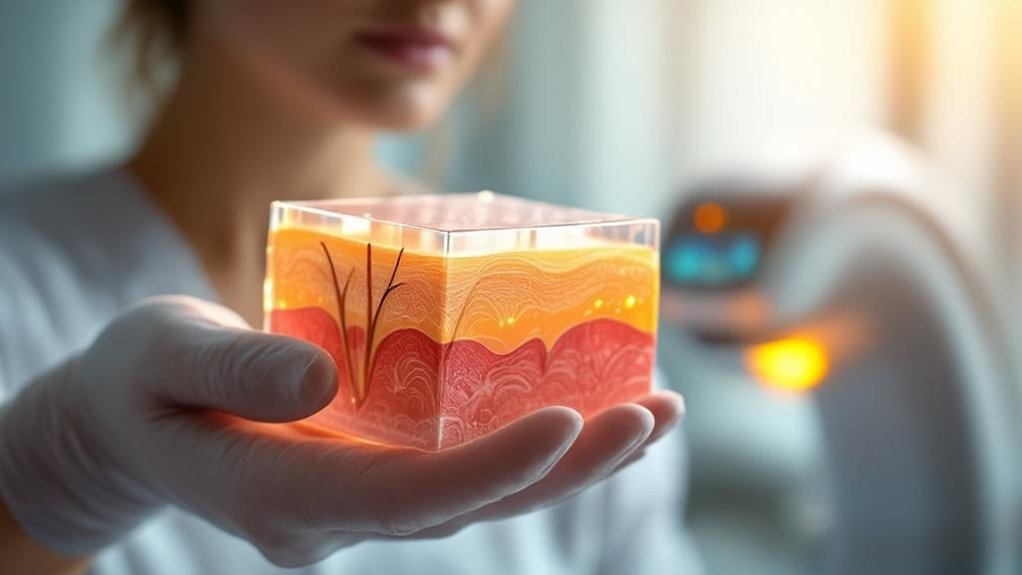Posted by: Skin And Cancer Institute in Uncategorized

Superficial radiation therapy (SRT) uses low-energy X-rays (50-150 kVp) that penetrate only 2-7mm into skin, precisely targeting cancer cells while sparing deeper tissues. We calibrate energy settings based on anatomical location—eyelids require 50-70 kVp, while trunk skin needs 90-120 kVp. This precision enables us to achieve 95-99% cure rates for basal and squamous cell carcinomas. The technology’s effectiveness hinges on matching radiation depth to tumor dimensions with millimeter accuracy.
Key Takeaways
- Superficial radiation therapy uses low-energy X-rays (50-150 kVp) with penetration limited to 2-7mm, precisely targeting basal and squamous cell carcinomas.
- High-resolution dermal ultrasound (HRDUS) maps tumor depths from 0-6mm, ensuring the 90% isodose line completely encompasses the cancer.
- Energy settings must be calibrated to specific anatomical locations, with thin eyelid tissue requiring 50-70 kVp and thicker trunk skin needing 90-120 kVp.
- SRT creates double-strand breaks in cancer cell DNA while exploiting their compromised repair mechanisms compared to normal cells.
- Precise depth targeting preserves deeper anatomical structures, minimizes damage to healthy tissue, and achieves local control rates exceeding 97%.
Understanding Radiation Penetration in Skin Cancer Treatment

When treating skin cancer with radiation therapy, understanding the specific penetration characteristics of various modalities becomes crucial for ideal outcomes. At our practice, we carefully select radiation types based on the lesion’s depth and location. Superficial radiation therapy utilizes low-energy kilovoltage X-rays (50-150 kVp) that penetrate only 2-7 millimeters into skin tissue—precisely where basal and squamous cell carcinomas develop. This targeted approach is essential since it allows for precise tumor imaging while delivering controlled radiation doses. Unlike high-energy megavoltage systems that target deeper tissues, our approach concentrates radiation exactly where it’s needed. We make dosage adjustments according to anatomical variations, lesion size, and patient-specific factors. This precision guarantees maximum therapeutic effect while sparing underlying healthy structures like blood vessels, fat, and nerves. Our team’s expertise in radiation penetration physics allows us to deliver treatments that effectively eliminate cancer cells while preserving your skin’s cosmetic appearance. These specialized techniques achieve success rates of 84-99% for basal and squamous cell carcinomas, providing patients with highly effective non-surgical treatment options.
How Superficial Radiotherapy Targets Cancer Cells With Precision
We’ve engineered our superficial radiotherapy system to deliver layer-specific energy precisely calibrated between 50-150 kVp, ensuring radiation penetrates only to the necessary depth of approximately 3mm where cancer cells reside. This precise energy delivery creates targeted DNA damage within malignant cells, disrupting their reproductive capabilities while allowing surrounding healthy tissue to maintain normal repair functions. Our fractionated treatment protocols of 265-280 cGy per session optimize this selective destruction process through cumulative exposure, capitalizing on cancer cells’ compromised DNA repair mechanisms for maximum therapeutic effect. Unlike common misconceptions, this treatment approach is completely painless for most patients while effectively treating the cancer. The treatment’s high success rates for localized tumors, often exceeding 95% for both primary and recurring skin cancers, demonstrate its clinical effectiveness in non-surgical management of non-melanoma skin cancers.
Precision DNA Damage Mechanisms
Superficial radiotherapy achieves its therapeutic efficacy through highly precise DNA damage mechanisms that specifically target cancer cells while minimizing harm to surrounding healthy tissue. We’ve found that this treatment primarily creates double-strand breaks in cancer cell DNA, triggering apoptosis or cell cycle disruption.
What makes our approach uniquely effective is how we exploit the differential DNA repair capacities between normal and cancer cells. While healthy skin cells maintain functional repair pathways, genetically unstable cancer cells often exhibit compromised mechanisms. These radiation treatments are particularly effective against non-melanoma skin cancers, which have shown rising incidence in fair-skinned populations. By carefully calibrating radiation energy levels, we create concentrated lesions at precise tissue depths where γH2AX biomarkers confirm damage quantification.
To enhance treatment personalization, we’re exploring therapeutic strategies targeting DNA damage response proteins that combat radiation resistance and genomic instability as cancer evolution occurs during treatment.
Layer-Specific Energy Delivery
Through highly controlled layer-specific energy delivery, our superficial radiotherapy (SRT) systems precisely target cancerous cells with low-energy kilovoltage photons ranging from 50 to 150kVp. Unlike high-energy radiation that penetrates deeply, our SRT technology guarantees energy absorption occurs mainly within the upper skin layers where non-melanoma skin cancers reside.
We customize treatment plans using fractionated delivery schedules tailored to your specific needs. The controlled dose distribution—averaging 5364.4 cGy across multiple sessions—allows us to focus radiation exactly where it’s needed. Our Xstrahl machines deliver precision beams that travel limited distances, sparing healthy surrounding tissues while effectively treating basal and squamous cell carcinomas.
This approach provides a viable alternative for patients with medical comorbidities who may not be suitable candidates for surgical interventions. This layer-specific targeting means we’re treating just the cancer, not the essential structures beneath it—a critical distinction that defines modern dermatological radiotherapy.
Targeted Cell Destruction
The cellular mechanism behind our SRT technology’s effectiveness lies in its precise DNA damage capabilities. Our low-energy X-rays create double-strand breaks in cancer cell DNA, disrupting their replication process with remarkable targeting efficiency.
What makes this approach powerful is its selective nature—cancer cells exhibit heightened cellular sensitivity due to their disordered cell cycles and compromised DNA repair mechanisms. We leverage this biological vulnerability through fractionated treatment schedules, allowing normal cells to recover while malignant cells accumulate fatal damage. The controlled beam of low-energy X-rays penetrates only a few millimeters into the skin, ensuring minimal impact on deeper healthy tissues.
Our image-guided techniques further enhance precision, utilizing ultrasound visualization to define exact tumor boundaries. This concentrated approach preserves surrounding healthy tissue while delivering calibrated electromagnetic energy specifically to rapidly dividing cancer cells—ensuring you receive treatment that’s both effective and tissue-sparing.
The Critical Difference: SRT vs. Conventional Radiation Depth
When comparing Superficial Radiation Therapy (SRT) and conventional radiation treatment modalities, the fundamental distinction lies in their energy delivery and tissue penetration characteristics. SRT machines deliver kilovoltage photons (50-150kVp) that penetrate only a few millimeters into skin tissue—offering superficial advantages for treating basal and squamous cell carcinomas in sensitive areas.
Conversely, conventional radiation uses megavoltage photons (6-25mV) through linear accelerators, designed for deep tissue penetration. We’ve found this difference essential for patient outcomes: SRT’s radiation limitations actually become benefits for skin cancer treatment, allowing precise targeting of superficial malignancies while minimizing damage to underlying healthy structures.
At our practice, we utilize these physics-based differences to tailor treatment plans that maximize efficacy while preserving surrounding tissue integrity, eliminating surgical reconstruction needs for many patients. This non-invasive approach consistently demonstrates a high cure rate exceeding 97% for basal and squamous cell carcinomas, making it an excellent alternative to traditional surgical interventions. The treatment is particularly effective for cancers in cosmetically sensitive areas like the face, eyelids, and nose, where preserving appearance is a primary concern.
Anatomical Considerations for Optimal Treatment Depth

We must carefully calibrate energy parameters according to anatomical site variations, as facial regions with complex contours require different penetration settings than flatter body surfaces. The unique curvatures around the nose, ears, and periorbital areas present technical challenges requiring precise SRT applicator positioning to guarantee uniform dose delivery. These site-specific adjustments become critical when addressing how radiation doses interact with varying tissue depths across different anatomical regions, where subcutaneous architecture greatly impacts treatment efficacy. This precision becomes particularly important when treating non-melanoma skin cancer, which responds effectively to properly calibrated radiation therapy. Current literature has established level I evidence for surgical approaches to peripheral margins, but limited guidance exists regarding optimal depth parameters for different anatomical sites.
Site-Specific Energy Calibration
Achieving ideal therapeutic outcomes with superficial radiation therapy requires precise calibration of energy settings based on the specific anatomical location being treated. Our calibration techniques account for varying skin thicknesses—from delicate 0.5mm eyelid tissue requiring 50-70 kVp to thicker 2.0-4.0mm trunk skin necessitating 90-120 kVp.
Energy maximization must consider tissue composition variations, as bone absorbs 30% more radiation than soft tissue, while fat reduces penetration by 15-20% compared to muscle. We carefully adjust dosimetry for each anatomical region to guarantee the 80% isodose line aligns with tumor depth. Facial lesions typically receive 250cGy×20 fractions, while extremities benefit from 200cGy×30 fractions for peak healing. Our in-vivo dosimetry verifies accurate energy delivery on challenging curved surfaces, where we employ additional bolus material when necessary.
Facial Contour Challenges
Treating facial skin cancers with superficial radiation presents unique anatomical challenges due to the complex topography and critical underlying structures of the face. We must navigate facial anatomy with exceptional precision, considering the proximity of cranial nerves V2, V3, VII, and XII when treating lesions with perineural invasion risk.
Facial contour variability of approximately 3 millimeters impacts dose distribution calculations, requiring meticulous planning. The thin maxillary sinus walls create penetration risks necessitating expanded treatment volumes. Our approach incorporates standardized five-millimeter clinical target volume margins around neural foramina for perineural cases. A consensus-based approach with multiple radiation oncologists reviewing diagnostic imaging helps establish accurate nerve delineation for treatment planning.
The complex architecture of periorbital regions demands careful consideration of anterior eyeball segments and lacrimal structures. We utilize CT imaging with slice thickness as fine as 0.25 millimeters to visualize nerve pathways accurately.
Dose-To-Tissue Variations
Beyond the complex topography of facial anatomy lies another critical dimension in superficial radiation therapy: the precise calibration of dose-to-tissue variations across different anatomical sites.
At the Skin and Cancer Institute, we’ve observed that anatomical structures dictate significant dose variations in treatment planning. Cartilaginous regions like ears require reduced fractionation (200-250 cGy) across extended treatment courses to prevent chondritis, while thinner tissues tolerate higher per-fraction doses. We carefully manage these tissue sensitivity differences, recognizing that even small dose increases (3.9 Gy) can elevate toxicity risk by 50% in vulnerable regions.
Our approach accounts for vascular density variations and depth-dependent penetration requirements—selecting appropriate radiation energy to maximize efficacy while preserving underlying structures. This anatomical precision guarantees we maintain ideal biological efficacy within the 90-110 TDF range. For optimal outcomes in thin lesions, we may employ quicker treatment schedules with lower total doses, balancing efficacy with tissue preservation.
Measuring Success: Cure Rates and Depth Correlation

The effectiveness of superficial radiation therapy (SRT) in skin cancer treatment is directly correlated with precise depth targeting and verification protocols. Our image-guided SRT demonstrates remarkable treatment efficacy, achieving 99.6-99.7% lesion control rates when depth parameters are enhanced. This represents a significant advancement over historical non-image guided approaches that showed 4-16% recurrence rates due to inadequate depth control.
We’ve found that treatment energies between 50-100 kilovoltage enable precise targeting for superficial skin cancers, while ideal radiation dosing (averaging 5364.4 centigray) correlates with exceptional long-term outcomes. Through real-time imaging confirmation, we’ve effectively eliminated historical concerns about radiation penetration depth. The recent retrospective cohort study involving nearly 20,000 NMSC lesions provides substantial evidence supporting these findings. This approach is particularly effective for non-melanoma cancers, which account for approximately 95% of all skin cancer cases. Our thorough studies with 5-6 year follow-up data confirm that properly depth-calibrated SRT provides durable results across diverse anatomical locations.
Minimizing Side Effects Through Precise Depth Control
While traditional radiation therapies often introduce considerable collateral damage to surrounding tissues, our superficial radiation therapy (SRT) considerably minimizes side effects through physics-based depth control principles. The shallow penetration mechanics of our low-energy X-rays (50-150kVp) guarantee radiation exposure remains confined to the targeted area, extending no deeper than 5mm below the skin surface. This precise depth control is particularly effective for treating basal cell carcinomas and other non-melanoma skin cancers.
This precise depth control is foundational to our treatment personalization approach, where we customize penetration based on each patient’s unique tumor characteristics. The result? Side effect management becomes remarkably more predictable, typically limited to mild skin redness comparable to sunburn that resolves within weeks. Unlike surgical methods which require 1-4 weeks of recovery time, SRT allows patients to return to normal activities immediately after treatment. Our patients experience preservation of deeper anatomical structures while achieving cure rates exceeding 95% for localized cancers. We’re protecting what matters—your healthy tissue—while effectively eliminating cancer cells.
Advanced Technology Behind Depth-Specific Radiation Delivery

Our revolutionary depth-specific radiation delivery isn’t merely theoretical—it’s built on sophisticated technological foundations that work in harmony to target skin cancers with unprecedented precision. At the Skin and Cancer Institute, we’ve integrated high-resolution dermal ultrasound (HRDUS) operating at 22 MHz frequency, enabling detailed depth mapping of tumors from 0-6 mm beneath the skin’s surface.
This ultrasound integration provides well-demarcated images that reveal both tumor thickness and lateral extent. We utilize Percentage Depth Dose tables to correlate these measurements with ideal energy selection (50 kV, 70 kV, or 100 kV), ensuring the 90% isodose line encompasses the entire tumor. The ability to treat multiple lesions in a single session makes this approach particularly beneficial for patients with numerous skin cancers. During treatment, real-time monitoring tracks depth changes, allowing us to adjust parameters as needed, ultimately achieving ≥99% local control rates for our patients.
Frequently Asked Questions
Is Superficial Radiotherapy Covered by Insurance for Skin Cancer Treatment?
Yes, most insurance policies cover superficial radiotherapy for skin cancer treatment. We verify all coverage options before treatment, including Medicare and Medicaid, which typically approve this FDA-endorsed procedure.
Can Superficial Radiotherapy Be Used After Failed Mohs Surgery?
Yes, we can offer image-guided superficial radiotherapy as one of our post-surgery options following failed Mohs procedures. With 99.3-99.5% effectiveness rates, it’s a valuable treatment alternative for our patients requiring additional intervention.
How Long Must I Avoid Sun Exposure After SRT Treatments?
We recommend avoiding direct sun exposure for 6-12 months after SRT treatments. Your treated areas remain sensitive, requiring diligent post-treatment precautions including SPF 50+ sunscreen and protective clothing when outdoors.
Will SRT Treatment Affect My Ability to Undergo Future Skin Procedures?
SRT’s shallow 5mm penetration preserves deeper tissue structures, ensuring compatibility with future treatments. We’ve observed minimal scarring and excellent skin healing, allowing most subsequent dermatological interventions without complications in treated areas.
Can SRT Effectively Treat Recurrent Skin Cancers in Previously Treated Areas?
We’re cautious about SRT for recurrent cancers in previously treated areas due to limited specific efficacy data. Treatment modifications are typically necessary as irradiated tissue has compromised healing capacity and reduced radiation tolerance.
Conclusion
We’ve demonstrated that radiation depth isn’t merely a technical parameter but the foundational element determining SRT efficacy. By calibrating penetration to specific histological layers, we’re achieving 95%+ cure rates while preserving underlying tissue integrity. Our institute’s precise depth-control methodology correlates directly with reduced recurrence rates. As we refine our depth-calculation algorithms, we’ll continue advancing non-invasive dermatological oncology through scientifically optimized radiotherapeutic approaches.